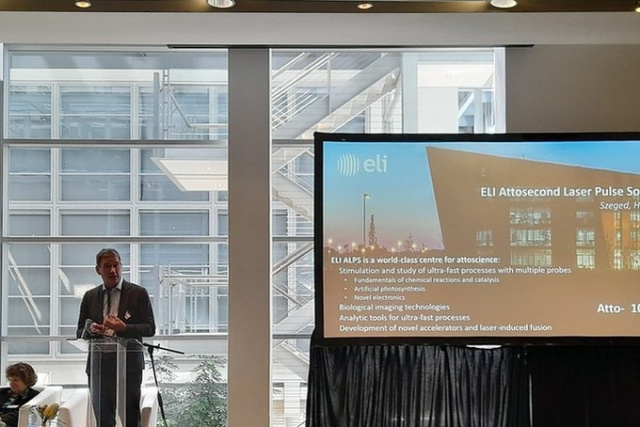Global challenges call for globally accessible research facilities – How to leverage large research infrastructure for the conduct of basic science for sustainable development?
A side event co-organised by the Alliance of International Science Organizations (ANSO), the Hungarian Academy of Sciences and the Department of Science and Innovation of South Africa, looked into the current availability of and future potential for large research facilities at the service of basic science working towards the fulfilment of the United Nations’ Sustainable Development Goals.
On the first day of the Forum, 6 December, the side event Basic Science for Sustainable Development: From the Perspective of Leveraging Global Large Research Infrastructures featured two speakers on behalf of the organisers, Professor Jinghua Cao, Executive Director of the ANSO Secretariat and Professor Zsolt Fülöp, President of the National Research Infrastructure Committee of Hungary and Doctor of MTA, as well as the following keynote speakers: Professor Di Li, FAST Chief Scientist, National Astronomical Observatories of the Chinese Academy of Sciences; Professor Catherine Cesarsky, Chair, Council of the Square Kilometre Array Observatory (SKAO); Professor Jiansheng Hu, Deputy Director, Institute of Plasma Physics, Chinese Academy of Sciences; Professor Andrew Harrison, Director of Science of the ELI-ERIC (Extreme Light Infrastructure – European Research Infrastructure Consortium); and Professor Yuao Chen, Executive Dean, School of Physical Sciences, University of Science and Technology of China (USTC).

The gist of the messages presented at the event can be summed up as follows: Major revolutionary innovation in science and technology often brings huge changes and upgrades to human lives, which is always rooted in breakthroughs in basic sciences. The importance of basic science research cannot be overstated, which – with the current stage of our knowledge – creates an urgent need for advanced research facilities. Large, global research infrastructures offer faster, farther-reaching solutions to extremely challenging problems. Many believe that the next revolutionary scientific discoveries will rely heavily on the use of such facilities. These facilities can help us deepen our understanding of the universe, the micro world and ourselves. Moreover, large research infrastructures can also assist us in exploring sustainable development strategies.
Large-scale science facilities, which enable a continuous exploration of the unknown, hold the solutions to many of the challenges that need to be overcome in order to achieve the United Nations’ Sustainable Development Goals. The goals are global, and so must be the tools that we use to achieve them. The operation and expansion of large research infrastructure facilities worldwide is an imperative, as we can take control of our own future only by carrying out big-data-based scientific research.
The keynote speakers of the session showcased various large-scale research facilities operational across five continents, with a special focus on China, Europe and South Africa. Apart from the scientific discoveries that are currently being targeted, special attention was given to the impact of such infrastructure on societies. It emerged that while the primary aim of these facilities is to provide basic research, they often also end up making a valuable contribution to overcoming health, energy and communication challenges.
At the event, a more detailed presentation was given on the SKAO, formally known as the SKA Observatory, which is an inter-governmental organisation composed of member states from five continents. Its mission is to build and operate cutting-edge radio telescopes to transform our understanding of the universe, while delivering benefits to society through global collaboration and innovation. Headquartered in the UK, its two telescope arrays will be constructed in Australia and South Africa and be the two most advanced radio telescope networks on Earth. By developing innovative technologies and through its contribution to addressing societal challenges, the SKAO will play its part in addressing the United Nations’ Sustainable Development Goals and delivering significant benefits across its membership and beyond. The SKAO recognises and acknowledges the indigenous peoples and cultures that originally inhabited the lands on which the SKAO facilities are located. The SKA project in South Africa is a clear example of the added value of such an investment. On the one hand, the project will allow researchers in Africa to use the facility in the future, and on the other hand, it will already be generating a boost for the innovation sector during the construction phase of the project.
In the question-and-answer part of the event, the speakers and the audience had the chance to exchange views, in particular about the involvement of Africa in the advancement of large research infrastructures. All the speakers were in agreement on the need to match cutting-edge basic research with cutting-edge technical facilities and to keep up and foster international collaboration to this end.
